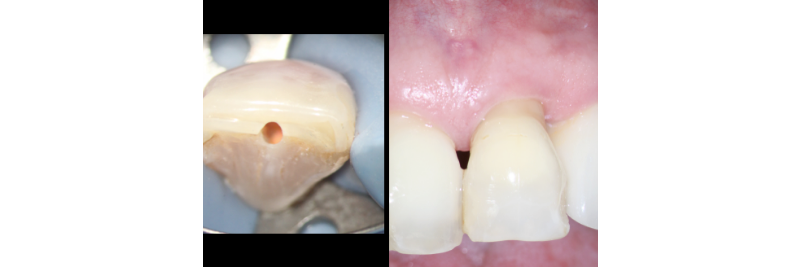One of the most challenging clinical situations encountered in practice is trying to restore a “dark tooth” in the esthetic zone (Figures 1A, 1B).


One treatment option that is often overlooked is internal non-vital tooth bleaching. This can be a wonderful treatment option if the tooth has had RCT or is in need of RCT (Figures 2A, 2B).


One reason I believe this treatment option is not often recommended is that most dentists were taught that internal non-vital tooth bleaching has a high risk of creating internal/external resorption. While this was true in the past, with the material changes (sodium perborate instead of hydrogen peroxide) and technique changes (walking bleach instead of heated bleach), the risks now are quite low.
The technique for “walking bleach” is outlined as:
- Leave gutta percha 1-2mm below the CEJ
- Place a “base” to seal the gutta percha
- Place sodium perborate in access against the barrier and seal
- Replace material as necessary to obtain desired change
- Wait 15 days before placing definitive composite restoration to close access (to obtain optimal bond strengths)
Predictability and stability
Abbott (2009) evaluated 225 teeth treated with internal bleaching and assessed color modification as “good” in 87.1% of the teeth and “fair” in 12.9% of the teeth.
Dark yellow and black teeth were less predictable (required more applications) than light yellow and grey teeth. Amato (2006) published a 16-year follow-up on 50 teeth treated with internal bleaching and reported that in 62.9% of the teeth the color had remained stable, while there was a marked color change in 37.1%.
Additionally, none of the teeth in this study had any signs of internal or external resorption at 16 years. A more recent paper (Amato, 2018) reported 85% of the teeth treated with internal bleaching had color stability at 25 years.
It must be stated that a large access preparation (Figures 2A, 2B) is not required to internally bleach non-vital teeth, as a larger access preparation further compromises the tooth structurally. Figures 3A and 3B illustrate successful outcomes with a much more conservative approach (treatment by Dr. Steve Baerg, Gig Harbor, Washington).


So, the next time you come across a dark tooth in the esthetic zone, ask yourself if internal bleaching is a possible treatment solution before you pick up the handpiece.
Dr. Greggory Kinzer, D.D.S., M.S.D., is a member of Spear Resident Faculty.
References
Internal bleaching of teeth: an analysis of 255 teeth Abbott P, Heah SY Aust Dent J. 2009 Dec;54(4):326-33
Bleaching teeth treated endodontically: long-term evaluation of a case series Amato M, Scaravilli MS, Farella M, Riccitiello F J Endod 2006 Apr;32(4):376-8
In-office and walking bleach dental treatments on endodontically-treated teeth: 25 years follow-up.
Amato A, Caggiano M, Pantaleo G, Amato M Minerva Stomatol 2018 Dec;67(6):225-230